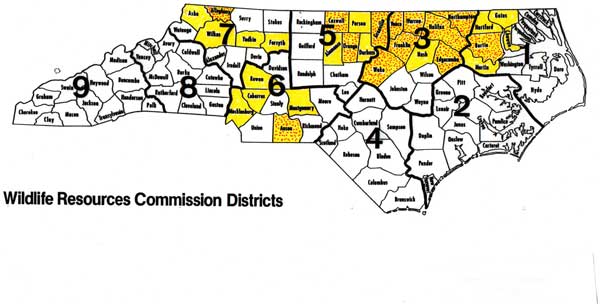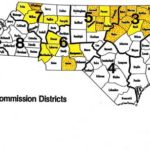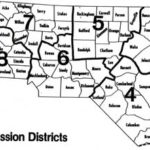
The N.C. Wildlife Resources Commission’s big-game sub-committee met July 7 in Raleigh to discuss proposing a statewide weapon-of-choice season for whitetail deer.It doesn’t matter what the details of that season were because it’s been taken off the table by the commissioners and replaced by another proposal. I was present when this new idea was first rolled out for discussion by District 8 Commissioner David Hoyle. In fact, I was the only non-committee member in the room. I made no comment about this or any other topic until I was recognized and called upon to speak.
I’m familiar with procedures the commissioners usually adhere to during the process of weeding through proposals they receive from the WRC’s professional staff, from commissioners and the public. In the past, all proposals have gone through a series of reviews beginning in July. During October, commissioners choose proposals to go to public hearings scheduled for January.
After two days of discussion (July 7-8), the regularly-announced Commission meeting was held July 9. At the conclusion of that meeting, Hoyle, to my surprise, read a statement that the commissioners were studying a tentative proposal – by them – that would create a special weapon-of-choice season only for private property. This season would begin the opening day of traditional archery season in early September and run through January 1 statewide.
I believe Hoyle said this proposal was tentative and open for discussion. A story in next day’s newspapers drew a lot of attention, so much that Hoyle called me Friday morning about the responses he had received to discuss some alternatives.
Fast forward to Oct. 2-3 to the WRC commissioners’meetings in Brevard. A new list of proposals was submitted by the wildlife agency’s staff, as usual. In an unprecedented move, a separate list of proposals was presented by the commissioners.
The staff proposed to open muzzle-loader season one week earlier, taking that week from the bow-only season. This is nothing really new, as similar proposals come up almost every year. But the commissioners proposed moving nearly the entire state into the longer, eastern deer season (and also proposed earlier muzzle-loader and gun seasons).
Their proposal read in part: Establish a uniform deer season (matching the current Eastern Deer Season) in and east of Yancey, McDowell and Rutherford counties.
But it’s significant the commissioners presented a separate list of proposals because that’s never happened in the past. It seems to give some credibility to the appearance that not only have some commissioners taken a more active part in running the agency, they’re actually giving orders directly to field-staff level employees without going through the usual chains of command. If this has occurred, the agency and its shareholders, N.C.’s sportsmen and sportswomen, have an even bigger problem.
That the proposals for the public input meetings are in two parts (staff and commissioners) sends a clear message. Sources indicate the commissioners wanted to consolidate the two lists, but staff disagreed and the proposals (prepared by the staff) were presented separately.
Now some commissioners have been heard to say they’re no longer willing to accept everything staff biologists recommend for regulation changes. Nor do they seem interested in what various hunting organizations or the general public has to say about their proposed changes.
It seems some commissioners simply think they know better what’s best for the resource than their paid professional staff and N.C.’s outdoorsmen. If that’s the case, do we need a professional staff of biologists if commissioners aren’t going to put stock in their work and recommendations?
The reason stated by Commission chair Wes Seegars for the proposal to move almost all of the state into the eastern deer season was “to create more hunting opportunities and to kill more deer.”
Most sportsmen probably agree N.C.’s deer population needs to be trimmed in some areas to maintain a strong, healthy herd. Lengthening the gun season for deer in the central, northwest and part of the western deer seasons may accomplish that goal.
However, the majority of deer that will be killed will be bucks because almost all hunters in the woods this time of year are horn hunting. But killing bucks, according to biologists, does nothing to control total deer numbers. It’s an established fact does must be killed to reduce deer populations. To adequately address that problem, does should be taken from areas where the problem is most prevalent, not everywhere in the state. A “one-size-fits-all solution” won’t solve this problem.
Opening the gun season three to four weeks earlier in the central, northwest and western areas (except for District 9) will result in mostly bucks being killed earlier than usual. By the time the mating season (rut) arrives in early November, those bucks that aren’t already dead will have taken to the thickest cover they can find and will remain there. Then a couple weeks after gun season opens in early November, deer sightings — buck sightings in particular — will become scarcer.
Move this two-week period after opening day of gun season back three to four weeks, and the same phenomenon will occur two weeks later – before the rut begins. More importantly, what will occur will be reduced buck sightings and an overall reduction in the number of bucks remaining for hunters the rest of the season. The same will occur in subsequent seasons.
In effect, this proposal will turn North Carolina into South Carolina, as far as quality of bucks is concerned (lots of deer with few trophies). The time, work, energy and monetary investment by private landowners and individuals during the past 10 years to improve the quality of N.C.’s buck population will be at risk of being wiped out – not to mention the planning of the WRC’s deer biologists.
A WRC goal that NCBA and other hunting groups support is to recruit and retain more hunters. We also want to preserve the quality of the hunting experience to meet hunter expectations and overall hunter satisfaction.
Many quality-deer-management advocates believe an Earn-A-Buck approach will work in North Carolina because it’s been used at other states with success. EAB demands hunters harvest one or two does before they can take their second or any subsequent buck.
EAB and other hunter groups suggested the program to the WRC this year. But no mention occurs in staff or commissioners’ proposals.
EAB obviously keeps bucks alive until they can grow, mature and pass on their genes. It also dictates more doe harvests. Reducing doe numbers not only helps grow bigger bucks but keeps the overall deer population in check.
One factor that may prevent this program from being adopted here is seed money. There’s no question it would cost to return to a hard-tagging system. But many deer hunters believe the change would be worth the investment.
Finally, the WRC needs to ask where should extra deer be harvested. Last year N.C. hunters tagged a record 171,000 whitetails and a 10-percent increase above 2006. That include a 28-percent increase in doe harvests but a buck harvest decrease of 2 percent (exactly what is needed).
According to graphs accompanying this story, WRC biologists believe about 200,000 deer need to be killed in North Carolina annually (31,000 more than 2007). But the extra harvest should come from only 29 of N.C.’s 100 counties. Thirteen counties would comprise the bulk of the extra kill with an excess of 1,000 additional deer from each county. Eight of these counties are already in the Eastern Zone (with the state’s longest gun season).
The biologists’ report recommends no harvest increase for 71 of the state’s 100 counties. The bulk of the counties needing immediate attention are located in the northeast section of the state. The report also recommends no increase in deer kills in Wildlife Districts 2 and 4 (in the Eastern Zone).
Yet the commissiones propose to move all counties in and east of Yancey, McDowell and Rutherford into the Eastern season with no biological data to support this change, and no logical reason other than to fulfill the personal wants of some commissioners and hunters to simply lengthen the gun season throughout almost 90 percent of the state.
Indications are the commissioners haven’t seen the in-depth staff report showing counties where additional deer should be harvested. The only information they got was the total number of additional deer biologists recommended for harvest (31,252 animals).
The obvious question is why didn’t the commissioners want to see the entire report (see charts with this story)? We wonder if some commissioners withheld this information from others?
Many deer hunters may like the prospect of a longer gun season. But they may not be considering what such a change will do to the quality of deer hunting.
Hunters need to pay close attention to what wildlife professionals and deer management experts say about this and other issues that affect the overall health and quality of our wildlife resources before plunging headstrong into massive changes to hunting seasons that have been fine-tuned for more than a half-century.
Simply put, sportsmen shouldn’t support massive changes in N.C.’s deer seasons that have no valid biological reasons.





Be the first to comment